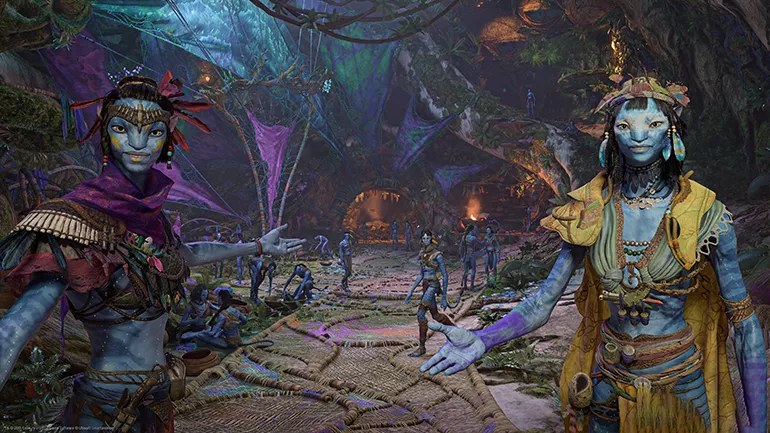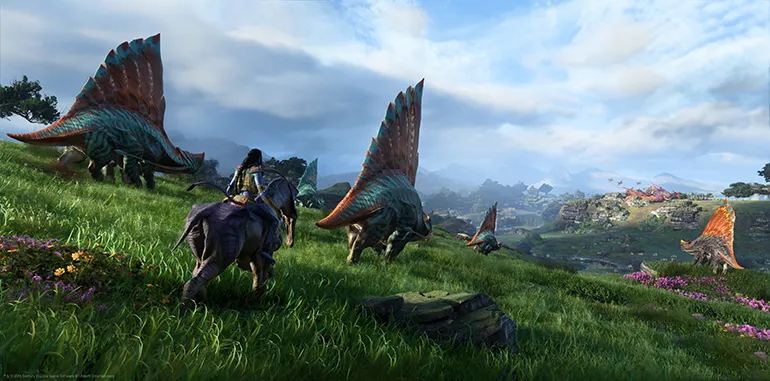The protagonist of Avatar: Frontiers of Pandora finds themselves in a constant struggle between two identities. On one hand, they are a true Na'vi, a descendant of a peaceful race that thrives in the forested beauty of Pandora. However, their true heritage is marred by a dark past, having been forcibly taken as a child and thrown into an experimental military program by humans.
As they manage to escape the clutches of the villainous Resources Development Administration (RDA) and return to their beloved world, a personal crisis emerges. How can they reconcile their gun-toting, hacker skills with the serene and harmonious nature of the Na'vi and the majestic trees that define their existence? It is a dilemma that will test their resilience and force them to discover their own path towards acceptance and belonging.
Ubisoft's latest open-world adventure seems to embody a sense of confusion in its design, mirroring the complex nature of the world it immerses players in. On one hand, it offers a thought-provoking narrative that follows the Na'vi on a journey towards living harmoniously with the natural world. These moments provide a serene experience, akin to a gentle survival game where players must carefully navigate and sustain themselves in the wilderness.
However, in an attempt to cater to a wider audience, the game also incorporates elements of a rowdy first-person shooter, complete with explosive action and precise headshots. These two disparate halves of the game are awkwardly stitched together, creating a dissonance that feels reminiscent of Frankenstein's monster.
Avatar: Frontiers of Pandora, the highly anticipated video game adaptation of James Cameron's groundbreaking film, seems to be caught in a contradictory pursuit. On one hand, it aims to stay true to Cameron's cinematic vision by immersing players in the vibrant and intricate world of the Na'vi culture. However, it also tries to cater to the popular demand for open-world action games by incorporating numerous tropes of the genre.
This juxtaposition becomes evident when considering the game's central theme of the Na'vi race being in harmony with nature and only taking what it needs. Despite this, Frontiers of Pandora appears to be fixated on delivering an abundance of content and excessive gameplay elements. While the game's ambition is admirable, it raises the question of whether it can truly capture the essence and spirit of the original film while succumbing to the allure of gaming conventions.
Discovering Pandora's Wonders
Frontiers of Pandora marks the exciting return of the Avatar film series to the world of video games, following the disappointment of its predecessor, Avatar: The Game, released in 2009. This time, however, the project is much larger in scale and boasts the involvement of the acclaimed studio Massive Entertainment, known for their work on Tom Clancy's The Division. The collaboration between Massive Entertainment and Ubisoft presents a compelling argument for why Avatar is perfectly suited for an open-world framework.
The game incorporates elements such as crafting, cooking meals, harvesting materials, bartering with vendors, building reputation with factions, and even tracking trails using a special sense. These aspects align seamlessly with the immersive world of Pandora and the activities one would expect the Na'vi people to engage in. With this ambitious undertaking, Frontiers of Pandora promises to deliver an immersive and authentic gaming experience that fans of both the film series and open-world games will surely appreciate.
Despite being formulaic, Massive, the developers of the game, have taken thoughtful consideration in adapting some of these ideas to align with the ethos of the race. For example, when players want to collect fruit from a tree, they are not simply required to press a button and hastily devour as much as they can. Instead, an engaging mini-game is triggered, where players must delicately pluck the resource, ensuring none of it goes to waste. This attention to detail reflects the Na’vi's belief in the sanctity of their planet, and it demonstrates how Massive goes the extra mile to ensure that their values are respected.
The success of the guiding philosophy in the open-world genre is largely due to the incredible world of Pandora. This expansive planet is meticulously crafted with intricate details and boasts a plethora of vibrant flora that adorns every inch of its land. Pandora's map is a sprawling expanse, teeming with multilayered vertical spaces, deep caves, and floating islands, all expertly designed to perfectly capture the breathtaking beauty of James Cameron's filmic world. Even after completing the game, I am certain that I have only witnessed a small fraction of Pandora's picturesque vistas, leaving me in awe of its vastness and magnificence.
In Frontiers of Pandora, the grand design of the game serves a purpose beyond simply filling space. The game encourages players to truly immerse themselves in the ecosystem and learn about it. Rather than providing exact markers to follow for missions, players are given a set of instructions that point them towards nearby landmarks. Additionally, a deep tracking system provides players with information on every single plant and where to find them.

Instead of using big icons to indicate important trees that offer health upgrades or skill points, these trees are subtly represented by glowing lights. This means that players must take the time to explore and learn the land in order to grow stronger, rather than relying on menus. It is worth noting that the open-world map in the game is nearly illegible due to a tiny user interface, further emphasizing the importance of learning the environment.
Frontiers of Pandora truly captivated me when I had the opportunity to fully immerse myself in the world of the Na'vi. The moments that resonated with me the most were not the grand story missions, but rather the spontaneous experiences where I could freely explore the environment on the back of my flying Ikran. The exhilarating sensation of swooping down towards the ground and skimming the surface of a serene lake, watching as my Ikran caught energy-restoring fish in its mouth, left me in awe.
This game is at its best when it embraces its wilderness survival aspect, although the constant need to consume meals to manage energy can be somewhat perplexing. If Frontiers of Pandora fully embraced this style and created an Avatar-themed version of games like Subnautica, it would undoubtedly be the perfect adaptation. However, it is important to note that this split identity also has its positive aspects.
Frontiers of Pandora, with its Na'vi-centric design, showcases an impressive and inventive spirit. The game captures the beauty and serenity of the natural world, offering breathtaking moments of platforming that immerse players in the vibrant landscapes of Pandora. However, despite these remarkable elements, the game falls short in other areas.
The sudden shift to first-person shooting feels out of place and disconnected from the overall experience. It feels as if this aspect was borrowed from another game entirely, with Far Cry being the most apparent inspiration. This lack of originality and creativity in certain aspects of the game leaves players yearning for a more cohesive and imaginative experience throughout.
Frontiers of Pandora, the highly anticipated game, has taken a controversial approach by cloning the DNA of the original series to form the foundation for its Hollywood-style action. However, this decision has proven to be jarring for many players. The majority of the main story missions revolve around infiltrating RDA bases and disrupting their environmentally destructive operations by causing explosions and shutting down gas valves. This stark change from the peaceful exploration that initially captivated players is unsettling.
Suddenly, the protagonist transforms from a stealthy infiltrator to a merciless killing machine, stealthily taking out unsuspecting humans with arrows, and unleashing a barrage of gunfire upon reused mechs when the situation escalates. The shift in gameplay dynamics is a far cry from the tranquil and immersive experience that won the hearts of fans.
While the core action loop in Sony's Horizon series is undeniably “fun,” there is a disconnect between the gameplay and the overall peaceful design of the game. The combat mechanics, particularly the archery, offer a satisfying experience as I take down RDA goons with deadly precision. Additionally, the outpost missions provide an exhilarating stealth element, allowing me to silently climb mechanical towers and disrupt military operations like a shadow.
However, these intense moments of combat seem incongruous with the game's emphasis on peace. It feels strange to be mowing down hordes of humans without a care, igniting them with exploding barrels, or electrocuting mech pilots with an electrified spear. This lack of harmony between the gameplay and the game's peaceful design is a notable flaw.
In the immersive world of Frontiers of Pandora, the intentional and effective feeling of reclaiming stolen heritage is established through a compelling narrative introduction. As a player, I anticipated shedding the tools of my oppressors and embracing my Na'vi heritage, envisioning a profound transformation in the game. However, the story disappointingly falls short of exploring this loaded setup.
From the moment I set foot in Pandora, little time is spent unlearning my human habits or fully embracing my heritage. Throughout the game, I remain a hybrid, engaged in relentless gunfights against waves of humans and even wild animals. The tragic backstory that initially seemed promising now feels like a convenient plot device designed to perpetuate gun violence, catering to the demands of a commercially successful video game.
The politics surrounding the game Frontiers of Pandora are a topic of debate. Some may argue that the game addresses the issues present in its film counterparts by focusing on the Na'vi rather than human allies. They may see it as a harmless shooter that portrays an oppressed group reclaiming their land and using their enemies' tools against them. There is a certain satisfaction in engaging in a fantasy context of eco-terrorism. However, a part of me feels uneasy witnessing an allegory for indigenous struggle being reduced to another Westernized power fantasy. It raises questions about the representation and appropriation of indigenous cultures in popular media.
Exploring the Vastness of Frontiers of Pandora's World
Frontiers of Pandora, much like other Ubisoft games such as Assassin's Creed and Far Cry, suffers from a bloated and formulaic structure. The game is packed with an overwhelming amount of content, catering to the most devoted players who enjoy meticulously completing every sidequest, conquering bases, and collecting loot. While this may not necessarily be a negative aspect, it can become tiresome and repetitive.
However, when I'm not focused on ticking off items from a checklist, there is a certain satisfaction that arises from stumbling upon hidden points of interest within the rich and immersive world. Encountering a Na'vi totem nestled in the wilderness, with its woven arrows guiding me through the area, feels like a natural and integral part of the game's universe. The strong world design diminishes the sense of artificiality in this discovery loop, making it a more enjoyable experience.
One of the most frustrating aspects of the game is its repetitive nature. It seems as though every mission follows the same formula: follow a scent through the woods, engage in combat with enemies, collect loot, and then return to a base for a dull conversation with a non-playable character. Occasionally, there is a need to use my senses to engage in deduction, which involves straining to locate tiny interactable items scattered across a meticulously detailed forest floor.
To make matters worse, Massive Entertainment even includes an overused hacking minigame that feels completely out of place, as if it were borrowed directly from Cyberpunk 2077 instead of being a part of the immersive world of Avatar. The lack of originality and repetitive gameplay mechanics make the game feel stale and uninspired.


Frontiers of Pandora presents a mixed bag of tropes, some of which seem obligatory and forced rather than organic. This is particularly evident in its RPG looter shooter gear system, which can be quite frustrating. Similar to a live service MMO, I am constantly acquiring new gear and mods, each with varying degrees of rarity and power attached to them. The strength of my gear determines my overall power level, which ultimately determines my ability to take on quests.
However, this power level can be deceptive. It only takes one overpowered gun to inflate my level, leading me to feel invincible as I confidently enter a firefight, only to be mercilessly annihilated due to my underpowered defenses. Moreover, finding suitable gear proves to be a hassle, as side missions yield inconsistent rewards and the need for constant crafting becomes tiresome.
The discrepancies I find in this game feel completely at odds with the core principles of the Na'vi code that I have learned elsewhere. It is perplexing to see a gluttonous cosmetic shop where players can indulge in microtransactions to customize their characters. Isn't the essence of being a Na'vi about taking only what we need, rather than accumulating rare gun modifications and Ikran saddles? It is ironic that Frontiers of Pandora aims to immerse players in the Na'vi experience, yet the controlling force behind it all remains undeniably human.
Frontiers of Pandora, the highly anticipated Avatar game, offers players a chance to escape into the mesmerizing world of Pandora. Despite the underlying issues and controversies surrounding the game, one cannot deny the sheer beauty and immersive experience it provides. The open world of Pandora is teeming with life and intricately designed landscapes, captivating players with its vibrant colors and rich details.
Moreover, the game delivers adrenaline-pumping moments through intense firefights and grand-scale set pieces, ensuring a thrilling blockbuster experience. While some may criticize the game for its lack of originality and bloated gameplay, the undeniable allure of its visual splendor makes it a worthwhile adventure. In the end, perhaps it is the stunning beauty of Frontiers of Pandora that truly matters, allowing players to indulge in the spectacle and escape from reality.




